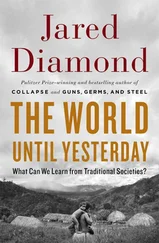Jared Diamond - Guns, Germs & Steel
Здесь есть возможность читать онлайн «Jared Diamond - Guns, Germs & Steel» весь текст электронной книги совершенно бесплатно (целиком полную версию без сокращений). В некоторых случаях можно слушать аудио, скачать через торрент в формате fb2 и присутствует краткое содержание. Жанр: 105. Описание произведения, (предисловие) а так же отзывы посетителей доступны на портале библиотеки ЛибКат.
- Название:Guns, Germs & Steel
- Автор:
- Жанр:
- Год:неизвестен
- ISBN:нет данных
- Рейтинг книги:5 / 5. Голосов: 1
-
Избранное:Добавить в избранное
- Отзывы:
-
Ваша оценка:
- 100
- 1
- 2
- 3
- 4
- 5
Guns, Germs & Steel: краткое содержание, описание и аннотация
Предлагаем к чтению аннотацию, описание, краткое содержание или предисловие (зависит от того, что написал сам автор книги «Guns, Germs & Steel»). Если вы не нашли необходимую информацию о книге — напишите в комментариях, мы постараемся отыскать её.
Guns, Germs & Steel — читать онлайн бесплатно полную книгу (весь текст) целиком
Ниже представлен текст книги, разбитый по страницам. Система сохранения места последней прочитанной страницы, позволяет с удобством читать онлайн бесплатно книгу «Guns, Germs & Steel», без необходимости каждый раз заново искать на чём Вы остановились. Поставьте закладку, и сможете в любой момент перейти на страницу, на которой закончили чтение.
Интервал:
Закладка:
3 5 8 ' GUNS, GERMS, AND STEEL
societies (the Andes, Mesoamerica, and the U.S. Southeast) were never connected by fast, high-volume trade on the scale that brought plague influenza, and possibly smallpox to Europe from Asia. As a result, even malaria and yellow fever, the infectious diseases that eventually became major obstacles to European colonization of the American tropics, and that posed the biggest barrier to the construction of the Panama Canal are not American diseases at all but are caused by microbes of Old World tropical origin, introduced to the Americas by Europeans.
Rivaling germs as proximate factors behind Europe's conquest of the Americas were the differences in all aspects of technology. These differences stemmed ultimately from Eurasia's much longer history of densely populated, economically specialized, politically centralized, interacting and competing societies dependent on food production. Five areas of technology may be singled out:
First, metals—initially copper, then bronze, and finally iron—were used for tools in all complex Eurasian societies as of 1492. In contrast, although copper, silver, gold, and alloys were used for ornaments in the Andes and some other parts of the Americas, stone and wood and bone were still the principal materials for tools in all Native American societies, which made only limited local use of copper tools.
Second, military technology was far more potent in Eurasia than in the Americas. European weapons were steel swords, lances, and daggers, supplemented by small firearms and artillery, while body armor and helmets were also made of solid steel or else of chain mail. In place of steel, Native Americans used clubs and axes of stone or wood (occasionally copper in the Andes), slings, bows and arrows, and quilted armor, constituting much less effective protection and weaponry. In addition, Native American armies had no animals to oppose to horses, whose value for assaults and fast transport gave Europeans an overwhelming advantage until some Native American societies themselves adopted them.
Third, Eurasian societies enjoyed a huge advantage in their sources or power to operate machines. The earliest advance over human muscle power was the use of animals—cattle, horses, and donkeys—to pull plows and to turn wheels for grinding grain, raising water, and irrigating or draining fields. Waterwheels appeared in Roman times and then proliferated, along with tidal mills and windmills, in the Middle Ages. Coupled to systems of geared wheels, those engines harnessing water and wind powe were used not only to grind grain and move water but also to serve myna
HEMISPHERES COLLIDING • 359
manufacturing purposes, including crushing sugar, driving blast furnace Tellows, grinding ores, making paper, polishing stone, pressing oil, producing salt, producing textiles, and sawing wood. It is conventional to define the industrial Revolution arbitrarily as beginning with the harnessing of steam power in 18th-century England, but in fact an industrial revolution based on water and wind power had begun already in medieval times in many parts of Europe. As of 1492, all of those operations to which animal, water, and wind power were being applied in Eurasia were still being carried out by human muscle power in the Americas.
Lone before the wheel began to be used in power conversion in Eurasia, it had become the basis of most Eurasian land transport—not only for animal-drawn vehicles but also for human-powered wheelbarrows, which enabled one or more people, still using just human muscle power, to transport much greater weights than they could have otherwise. Wheels were also adopted in Eurasian pottery making and in clocks. None of those uses of the wheel was adopted in the Americas, where wheels are attested only in Mexican ceramic toys.
The remaining area of technology to be mentioned is sea transport. Many Eurasian societies developed large sailing ships, some of them capable of sailing against the wind and crossing the ocean, equipped with sextants, magnetic compasses, sternpost rudders, and cannons. In capacity, speed, maneuverability, and seaworthiness, those Eurasian ships were far superior to the rafts that carried out trade between the New World's most advanced societies, those of the Andes and Mesoamerica. Those rafts sailed with the wind along the Pacific coast. Pizarro's ship easily ran down and captured such a raft on his first voyage toward Peru.
inaddition to their germs and technology, Eurasian and Native American societies differed in their political organization. By late medieval or Renaissance times, most of Eurasia had come under the rule of organized states. Among these, the Habsburg, Ottoman, and Chinese states, the Mogul state of India, and the Mongol state at its peak in the 13th century started out as large polyglot amalgamations formed by the conquest of other states. For that reason they are generally referred to as empires. Many Eurasian states and empires had official religions that con-»• uted to state cohesion, being invoked to legitimize the political leader-s »P and to sanction wars against other peoples. Tribal and band societies
360 • GUNS, GERMS, AND STEEL
in Eurasia were largely confined to the Arctic reindeer herders, the Siberian hunter-gatherers, and the hunter-gatherer enclaves in the Indian subcontinent and tropical Southeast Asia.
The Americas had two empires, those of the Aztecs and Incas, which resembled their Eurasian counterparts in size, population, polyglot makeup, official religions, and origins in the conquest of smaller states. In the Americas those were the sole two political units capable of mobilizing resources for public works or war on the scale of many Eurasian states, whereas seven European states (Spain, Portugal, England, France, Holland, Sweden, and Denmark) had the resources to acquire American colonies between 1492 and 1666. The Americas also held many chiefdoms (some of them virtually small states) in tropical South America, Meso-america beyond Aztec rule, and the U.S. Southeast. The rest of the Americas was organized only at the tribal or band level.
The last proximate factor to be discussed is writing. Most Eurasian states had literate bureaucracies, and in some a significant fraction of the populace other than bureaucrats was also literate. Writing empowered European societies by facilitating political administration and economic exchanges, motivating and guiding exploration and conquest, and making available a range of information and human experience extending into remote places and times. In contrast, use of writing in the Americas was confined to the elite in a small area of Mesoamerica. The Inca Empire employed an accounting system and mnemonic device based on knots (termed quipu), but it could not have approached writing as a vehicle for transmitting detailed information.
THUS, eurasian societies in the time of Columbus enjoyed big advantages over Native American societies in food production, germs, technology (including weapons), political organization, and writing. These were the main factors tipping the outcome of the post-Columbian collisions. But those differences as of a.d. 1492 represent just one snapshot of historical trajectories that had extended over at least 13,000 years in the Americas, and over a much longer time in Eurasia. For the Americas, in particular, the 1492 snapshot captures the end of the independent trajectory of Native Americans. Let us now trace out the earlier stages of those trajectories.
HEMISPHERES COLLIDING • 361
Table 18-1 summarizes approximate dates of the appearance of key developments in the main "homelands" of each hemisphere (the Fertile Crescent and China in Eurasia, the Andes and Amazonia and Mesoamerica the Americas). It also includes the trajectory for the minor New World homeland of the eastern United States, and that for England, which Ot a homeland at all but is listed to illustrate how rapidly developments
spread from the Fertile Crescent.
This table is sure to horrify any knowledgeable scholar, because it reduces exceedingly complex histories to a few seemingly precise dates. In reality, all of those dates are merely attempts to label arbitrary points along a continuum. For example, more significant than the date of the first metal tool found by some archaeologist is the time when a significant fraction of all tools was made of metal, but how common must metal tools be to rate as "widespread"? Dates for the appearance of the same development may differ among different parts of the same homeland. For instance, within the Andean region pottery appears about 1,300 years earlier in coastal Ecuador (3100 b.c.) than in Peru (1800 b.c.). Some dates, such as those for the rise of chiefdoms, are more difficult to infer from the archaeological record than are dates of artifacts like pottery or metal tools. Some of the dates in Table 18.1 are very uncertain, especially those for the onset of American food production. Nevertheless, as long as one understands that the table is a simplification, it is useful for comparing continental histories.
The table suggests that food production began to provide a large fraction of human diets around 5,000 years earlier in the Eurasian homelands than in those of the Americas. A caveat must be mentioned immediately: while there is no doubt about the antiquity of food production in Eurasia, there is controversy about its onset in the Americas. In particular, archaeologists often cite considerably older claimed dates for domesticated plants at Coxcatlan Cave in Mexico, at Guitarrero Cave in Peru, and at some other American sites than the dates given in the table. Those claims are now being reevaluated for several reasons: recent direct radiocarbon dat-mg of crop remains themselves has in some cases been yielding younger ates; the older dates previously reported were based instead on charcoal ought to be contemporaneous with the plant remains, but possibly not so, and the status of some of the older plant remains as crops or just as co lected wild plants is uncertain. Still, even if plant domestication did egm earlier in the Americas than the dates shown in Table 18.1, agricul-
Интервал:
Закладка:
Похожие книги на «Guns, Germs & Steel»
Представляем Вашему вниманию похожие книги на «Guns, Germs & Steel» списком для выбора. Мы отобрали схожую по названию и смыслу литературу в надежде предоставить читателям больше вариантов отыскать новые, интересные, ещё непрочитанные произведения.
Обсуждение, отзывы о книге «Guns, Germs & Steel» и просто собственные мнения читателей. Оставьте ваши комментарии, напишите, что Вы думаете о произведении, его смысле или главных героях. Укажите что конкретно понравилось, а что нет, и почему Вы так считаете.










